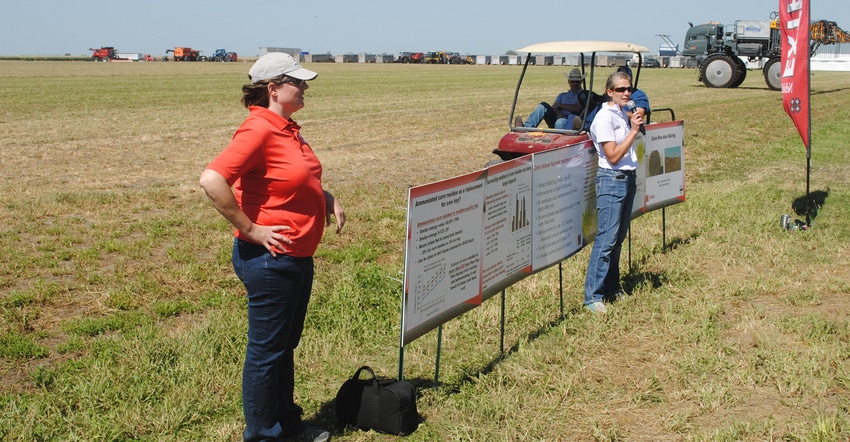
With high corn yields comes high corn residue after harvest. That can be a great resource, whether you are grazing the stalks or harvesting them for feed. Reducing residue on high-yielding cornfields can help with the implementation of reduced tillage systems in subsequent years.
At Husker Harvest Days, a group of Nebraska Extension educators developed an exhibit and presentation, in cooperation with numerous equipment manufacturers, on getting the most out of crop residue.
“We get questions about how much damage it does when we take residue off a field,” said Nebraska Extension educator Jenny Rees. “You can take various amounts of residue off the field. You don’t have to take all of it. You can take 50%, or you can take 20% to 30%.”
Rees said that 40 bushels per acre of corn or sorghum produces about 1 ton of residue. Producers shouldn’t harvest more than 2 tons of residue per acre in any given year, and they need to leave about 2.4 tons of residue on the field.
“That means that not every field will be suited for removing residue,” she said. “Landlords often want to know how much in nutrients are being removed,” Rees said. “For every ton of residue, roughly 17 pounds of nitrogen, 4 pounds of P2O5 [diphosphorus pentoxide] and 3 pounds of sulfur are removed.” About 34 pounds of potassium oxide (K2O) are being removed, but potassium is usually not an issue for Nebraska soils.
“We don’t recommend harvesting stover unless the yield is 180 bushels per acre or more, so as not to impact the soil,” Rees said. “On continuous corn, stover can be removed every other year. For corn-soybean rotations, it can be removed every four years, because soybeans don’t have much residue or stover. And we don’t want to remove residue from fields with a 5% slope or greater.”
Cover crops and manure can always be added to help improve soil properties on fields where stover has been harvested.
Harvesting methods do matter when it comes to feed value, said Nebraska Extension beef systems specialist Mary Drewnoski. Grazing is one viable, efficient option for harvest. Other options include the traditional rake and bale method; turning off the combine spreader during harvest and baling the tailings; and baling after the corn has been harvested with a New Holland Cornrower chopping head attachment.
Drewnoski said that all these harvest methods will provide an increase in feed value of the stover, with Nebraska Extension research showing the greatest increase from two rows chopped and baled under the Cornrower method.
With this method, processed cornstalks are funneled into a bank of knives that deliver a consistent chop of all the residue and deposit the resulting chopped stover into a dense windrow for baling. The windrows contain lost corn kernels, but are free from dirt clods and stones.
The more traditional rake and bale method of harvest has been employed over the past decade or more. Randy Worden, president of Rowse Rakes based in Burwell, Neb., said that Rowse’s crop-driven rakes hold a constant height and can take more than 98% of the corn residue from a field and still run the rake one-half inch off the ground.
“Last season, with a lot of downed corn on the ground, we had customers that were able to rake 80% of the downed ears back into a windrow for baling,” Worden said. “With our 4-inch spaced teeth on the rake, we can run almost 2 inches off the ground and still get half of the residue and leave some foliage on the ground.”
Worden said they advise customers to rake as high as they can through the cornstalks, and still take what they want from the field. “Our rake wheels have enough rake power to bust over heavy residue and pull the foliage through into a windrow,” he added.
Drewnoski noted that ammoniated corn residue is also an option for feeding, because it offers energy values equal to medium-quality hay. “You might waste a little more than feeding hay,” she said. “But if the price of corn residue is more than $32 less than hay, then buying the stalks and ammoniating them will reduce cow feed costs” without giving up on feed value.
Learn more about management of corn residue by contacting Drewnoski at [email protected], or Rees at [email protected].
About the Author(s)
You May Also Like






